Archived Mold Remediation Blog Posts
How to clean mold off of leather and clothes
11/29/2022 (Permalink)
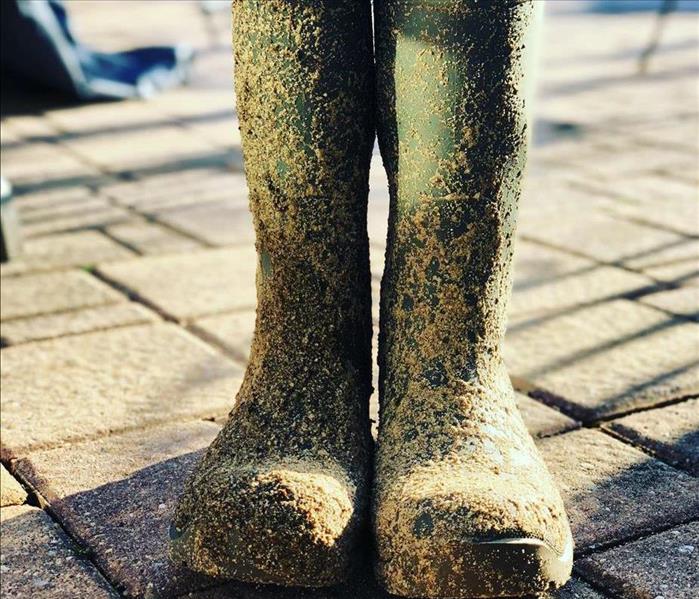 If you have limited time at home, no need to worry as there are house mold removal services like SERVPRO of Sanford
If you have limited time at home, no need to worry as there are house mold removal services like SERVPRO of Sanford
We usually wear leather boots and clothes this season and sometimes on rare occasions. When we put them in the closet waiting for the next event where we can wear them might cause certain damage, even mold. We would never want that to happen, right? Some of us who have limited time to clean our molded shoes and clothes might go to a mold removal service, but in this article, we’ll talk about ways to clean those molds.
How to get rid of mold in your body
- Remove visible mold growth on every surface as much as possible. You can do this by using house mold removal products, hot soapy water, or a mixture of 1 cup of bleach for 1 gallon of water.
- Remove and take away all discarded or porous materials like carpets, insulation, and wallboard when they are showing signs of mold.
- Contact a mold removal service for extensive mold growth in your home and a doctor if you have health effects that occur when cleaning moldy surfaces.
How to clean mold off of leather boots
Molds require moisture to grow and to get rid of it, moisture must be removed. Cleaning leather boots can be different depending on the brand. Some of them require a gentle touch to avoid damaging their surface. Before giving you tips, make sure that you are wearing a mask while removing the molds in the shoes.
- Dry-brush the surface with a stiff, nylon brush. It will brush away the mold and mildew that has built upon the surface of the leather shoe.
- For suede and nubuck leather types, the first step can be safely done. If the shoes need more cleaning because of the stains or mold returns repeatedly, use a suede cleaner.
- Moisten a soft cloth with a mixture of vinegar and water and use it to wipe the surface of the shoes where there is mold. Vinegar is effective against most types of mold.
How to clean mold off from clothes
Mold can also strike on clothes and when it happens it can ruin your outfit as it can be very visible. So to get rid of it, try the following:
- Bleach. One effective way to remove mold and mildew from clothing that is made of white cotton. Apply a ratio of 1:3, 1 part of bleach to 3 parts water to the stain, and sit it for a few minutes before starting to launder the clothes as usual.
- If your cloth is collared and cannot be bleached, try removing it with lemon juice or white vinegar. Soak a cotton pad in lemon juice or white vinegar and rub it on the stain. Soak it for several minutes.
- Sprinkle the area with some salt to further boost the effect of the acid from lemon juice or white vinegar. Place them in a sunny spot to dry as the sun rays can also bleach stains. Repeat as needed then launder the clothes.
If you have limited time at home, no need to worry as there are house mold removal services like SERVPRO of Sanford that is open and available 24-hour emergency service and highly trained mold and water damage restoration specialists.
Mold from Clothes: How to get rid of it
7/14/2022 (Permalink)
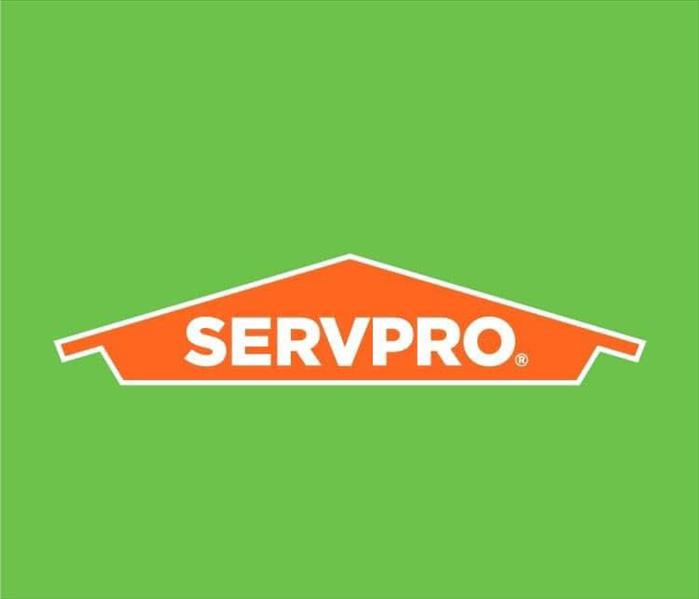 Mold cleanup might be a difficult task to handle on your own. We advise speaking with knowledgeable experts.
Mold cleanup might be a difficult task to handle on your own. We advise speaking with knowledgeable experts.
Dealing with mold and mildew can be a hassle, especially if they develop on your clothing. They can have a terrible odor in addition to being ugly. This can happen to items that have been left in a damp, dark spot for an extended period of time, or it could mean that your dryer or washer has mold or mildew in it. It's crucial to understand how to clean mold off of clothing because of this.
Mold stains can appear on clothing as a result of water contact or poor storage, and they can be challenging to get rid of. The clothes should be washed as soon as possible.
But you can remove mold stains from all types of clothes, even delicate materials, with the appropriate tools and care. The best approach to get mold out of garments is to give them a good wash. Make sure to adhere to the clothing's recommended water temperature.
Guidelines for Preventing and Removing Mold and Mildew on Clothes
Here are some guidelines to assist avoid and get rid of mold from spoiling your garments if proper washing is ineffective, for assistance you might also contact SERVPRO Sanford near you:
- In your washing hamper, do you find rotting clothes? Wet towels or garments at the bottom of the washing basket may be to blame for this. Before adding any soiled garments, use a disinfectant to get rid of any mold spores that may still be present.
- Regularly check your dryer and washing machine for mold. After a wash, if your clothing still has a musty scent, your washer may have mold. Run an empty cycle with hot water and bleach or detergent to remove the mold from the machine
If it doesn't work, carefully disassemble the washer and use hot water and a cleaning agent to remove any mold you detect. To get rid of as many mold spores as you can, use a gentle brush or an old toothbrush.
If it still doesn’t work, reach out to SERVPRO Sanford for an immediate action.
- Put wet clothing in the sun to dry. Mold spores can be killed naturally by sunlight, and a wind will help your garments breathe better.
- Put your clothing in a solution of vinegar. Black, non-porous, and porous mold can all be cleaned and disinfected using white vinegar. Undiluted white vinegar should be sprayed on the moldy regions. Additionally, you can mix a paste of salt and lemon juice to apply to moldy regions. After letting it sit for a while, wash it off. Equal parts of water and vinegar should be combined to create a solution. Before washing, let your garments soak in the solution for 30 minutes. Don't mix vinegar and bleach together.
- Laundry detergent and really hot water to wash your moldy garments. Laundry detergent will get rid of musty odors and kill mold spores. You should also soak your soiled item in a pre-soaking solution before washing it because mold stains are difficult to remove.
- Your wash cycle should now include baking soda. A natural deodorizer, baking soda can help get rid of musty odors from your clothing. Along with your regular detergent, add half a cup of baking soda to the wash cycle.
- Apply a mold stain remover like bleach, but make sure it's okay to use bleach by checking the labels on your clothing first. Start a typical cycle after adding the detergent and clothes. More additional tips can be given by professionals at SERVPRO cleaning near me.
After the washer has filled with water, pause the cycle, add a cup of bleach, and then restart the wash. Alternately, soak the clothing for at least an hour in a solution of one cup of bleach and two gallons of hot water.
- You can substitute vinegar, baking soda, borax, or ammonia for bleach in a manner that is similar. Add a cup of your preferred product after starting the wash cycle with your laundry and detergent.
Once the garments are thoroughly wet, switch off the cycle and wait at least an hour before starting it again. The chosen product will be able to combat the mold if the cycle is stopped while the clothing are still damp. Bleach and ammonia should not be combined as the resulting fumes can be toxic.
If you’re still having a hard time removing mold from your clothes, you may reach out to SERVPRO near my location for immediate action.
Search online for SERVPRO cleaning near me and you will be directed to our Professional Mold Remediation Service.
Mold cleanup might be a difficult task to handle on your own. We advise speaking with knowledgeable experts. For mold removal services, get in touch with SERVPRO professionals by searching SERVPRO near my location now. We take special pride in our ability to restore your house to its condition.
4 Tips On How To Check The Mold On Your Stucco Walls And How To Get Rid Of Them
1/18/2022 (Permalink)
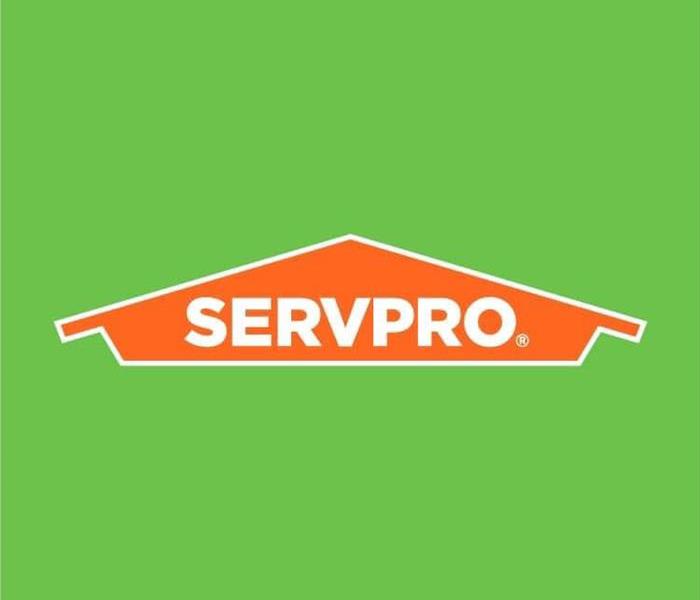 Stucco was once a definitive feature of Spanish and Mediterranean architecture and is now used in homes around the world.
Stucco was once a definitive feature of Spanish and Mediterranean architecture and is now used in homes around the world.
iding or cladding is the outermost layer of a house. There are many types of house siding like fiber-cement panels, vinyl siding, custom home sidings, and the other one used on houses for centuries, the stucco.
Stucco was once a definitive feature of Spanish and Mediterranean architecture. A professional mold restoration company can help in the proper maintenance of stucco walls. Its resilience and refined application techniques make it an ideal siding for homes in different climates and styles.
Modern stucco has polymers and other agents for increased flexibility and resilience. It is very durable but sometimes it can be a target of molds. Mold growing on exterior stucco walls is not only unsightly but it can cause larger problems if it gets between your home’s exterior stucco and framing. If you have been experiencing mold on your stucco, check out mold remediation near me.
In this article, we will give you tips on how to check if the mold has already penetrated your stucco walls and how to get rid of them.
- Preventing from developing molds
To check out if the stucco walls have developing molds, make sure water cannot pool anywhere along the base of the walls, or run down because of improperly installed or leaking gutters. Check for cracks or tears on its surfaces because mold can feed on the framing. Wash your exterior walls with diluted dish liquid and rinse with pressurized water. By doing this, it can remove the dust, dirt, and stray plant matter that mold loves to feed on.
- Identifying mold on the exterior
Molds look like molds on any surface; they can be green, dark brown, or black patches and streaks or fuzzy-looking stains. Checking around the gutter, windows, and doors frequently is a good habit to get rid of molds. Mold thrives in damp areas where there is a lot of plant matter.
- Removing mold on the exterior
Here’s a tip: brush away dirt and debris with a stiff-bristled brush and inspect your stucco to make sure there are no deep cracks or large tears. Mix together a solution of 5 parts water to 1 part oxygen bleach (chlorine bleach will also work but it might damage nearby plants). Wear rubber gloves and long sleeves to protect your hands and arms and spray the mold with the bleach solution. You can use a sponge to scrub away the mold and rinse thoroughly with clear water. You can also use a pressure washer or a garden hose. You will need the help of a professional mold restoration service if the situation is out of control or if you want your stucco to be inspected by experts.
Bonus Tip: It is advisable to inspect your exterior stucco at least every month to wipe away any visible debris and treat mold spots as they appear.
If the mold problems are not resolved by the bleach solution, it is time to get an expert. You can check out mold remediation near me to have a list of mold restoration companies, SERVPRO North Seminole are the experts on doing the job. They have state-of-the-art machines that can get rid of the molds easily and efficiently. They are also open 24 hours so you can call them any time of the day.
Preventing Attic Mold
7/16/2021 (Permalink)
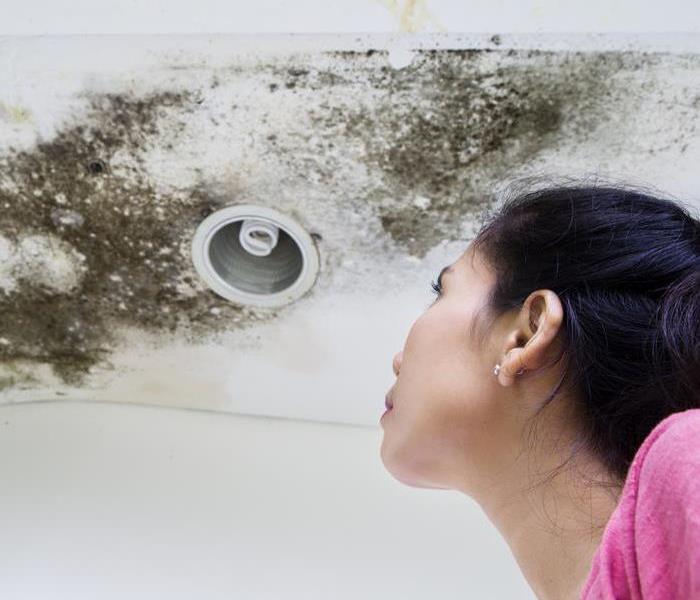 Attic mold can severely affect your home.
Attic mold can severely affect your home.
Anywhere in your home with moist, warm air is an ideal environment for mold to grow. For some of us, moist, warm air can be found in our attics. And unfortunately, many of us rarely, if ever, go up in our attics, so any problems can go unchecked for long periods of time. It’s important to check your attic periodically for common causes of attic mold.
Anything that introduces water or moisture to your attic can be a problem. Things like:
1) Leaking Roof - Sometimes a roof leak is bad enough that water leaks into the floors below and becomes immediately apparent. However often the leak is small enough to cause attic mold, without being apparent in the living spaces of the home.
2) Dryer Vents, Plumbing Vents, and Kitchen or Bathroom Fans vented in to the attic - This practice can pump warm, moist air into the attic where it can be trapped and begin the cycle of mold growth. It is always best to vent these items outside of the home.
3) Missing or Improperly Installed Insulation - Missing or improper installation of the wrong kind of insulation can cause problems in multiple ways. Moisture from the lower levels of the home can rise and get trapped in the attic. Additionally, it can create moisture or condensation in your attic. Think of your attic like a cold glass of ice water outside on a hot summer day. The water is a much lower temperature than the air around it and condensation develops on the glass. If there is missing or improperly installed insulation, this same principle can apply when your home is air conditioned to 70 degrees, but your attic temperature is 99 degrees. Lastly, missing or improperly installed insulation can lead to number four……
4) Ice Damming – An ice dam is a ridge of ice that forms at the edge of a roof and prevents melting snow (water) from draining off the roof. The water that backs up behind the dam can leak into your home and cause damage to walls, ceilings, insulation, and create a perfect environment for mold growth. It’s important before winter to clean your gutters so that winter’s melting snow and rain can properly drain off your roof. Additionally, improper insulation can contribute to ice damming by allowing warm air from inside your home to escape into the attic.
5) Inadequate Ventilation - It seems counter-intuitive, but the basic ventilation principal for your attic is to keep it as cool as possible during the cold season. Pay attention to your roof after snow storms. If you look at your roof several days after a snow and you see an even distribution covering your roof, that’s a good sign that your attic is properly ventilated. If on the other hand, you see sections where snow has melted, that suggests an area in the attic where warm air has been trapped instead of being properly vented to the exterior. Make sure your soffit vents are clear and free of things like debris, bird’s nests and insulation.
6) Water Heaters or Furnaces installed in the attic - While not a common practice in Wisconsin, sometimes homes without a basement will have water heaters or furnaces in the attic. You may also see this practice in larger homes with several heating and cooling zones, as well as spa style bathrooms with a huge soaking tub, where it is common practice to have designated systems to support these luxuries. Unfortunately, this practice can contribute to adding moisture to your attic and contribute to mold growth if there are any leaks from these items.
The Lingering Effect
12/10/2018 (Permalink)
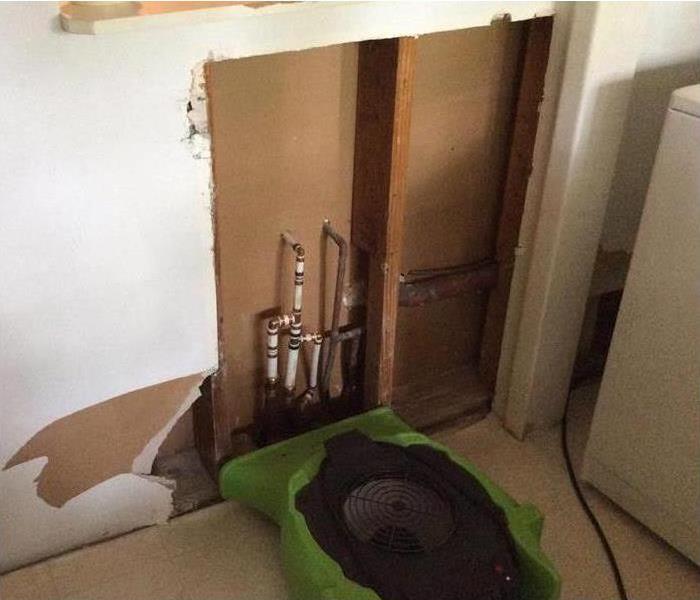 Mold that had been growing inside a wall due to water damage.
Mold that had been growing inside a wall due to water damage.
Mold. It is usually never foreseeable and never found until one day you open up that back storage closet that you NEVER go in and it smells a little strange. Moving things around you find it, and then you call us.
However, there are cases when a mold problem should be foreseeable and can hopefully be taken care of before it is even a problem. When does this occur?
During floods or water damages.
You should always be aware that anytime you have had flood damage to your home or place of business it is likely for mold growth to occur in that area. In fact, it's more than likely. That is why you always hire a water damage restoration specialist (we know a good one) to deal with flood or water damage. SERVPRO will make sure that you are at the least possible risk for any lingering mold growth.
Give us a call for a FREE mold inspection: 407-323-2422
Do I Have A Mold Issue?
12/10/2018 (Permalink)
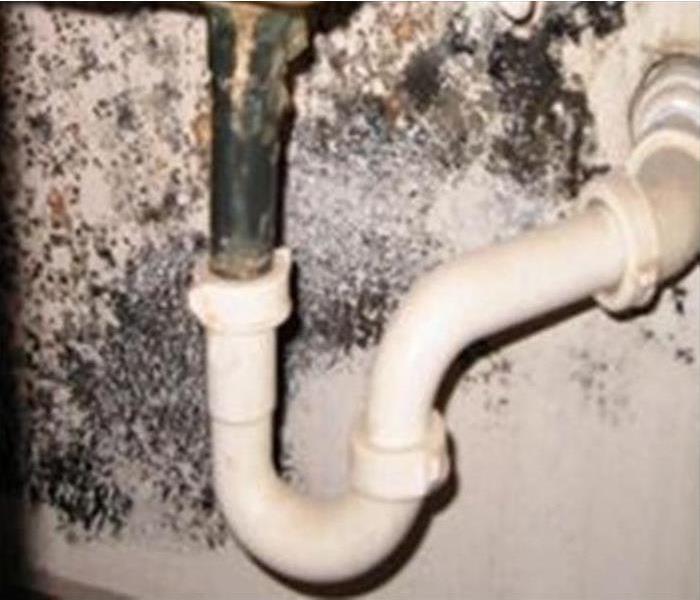 Mold can spread through a home in as little as 48 hours.
Mold can spread through a home in as little as 48 hours.
Microscopic mold spores naturally occur almost everywhere, both outdoors and indoors. This makes it impossible to remove all mold from a home or business. Therefore, mold remediation reduces the mold spore count back to its natural or baseline level. Some restoration businesses advertise “mold removal” and even guarantee to remove all mold, which is a fallacy. Consider the following mold facts:
- Mold is present almost everywhere, indoors and outdoors.
- Mold spores are microscopic and float along in the air and may enter your home through windows, doors, or AC/heating systems or even hitch a ride indoors on your clothing or a pet.
- Mold spores thrive on moisture. Mold spores can quickly grow into colonies when exposed to water. These colonies may produce allergens and irritants.
- Before mold remediation can begin, any sources of water or moisture must be addressed. Otherwise, the mold may return.
- Mold often produces a strong, musty odor and can lead you to possible mold problem areas.
- Even higher-than-normal indoor humidity can support mold growth. Keep indoor humidity below 45 percent.
If you think your home or business has a mold problem, we can inspect and assess your property and use our specialized training, equipment, and expertise to remediate your issue.
If You See Signs of Mold, have a musty odor or just want some peace of mind, call us today at 407-323-2422.
Mold Remediation Home Remedies - Don't Do It
11/26/2018 (Permalink)
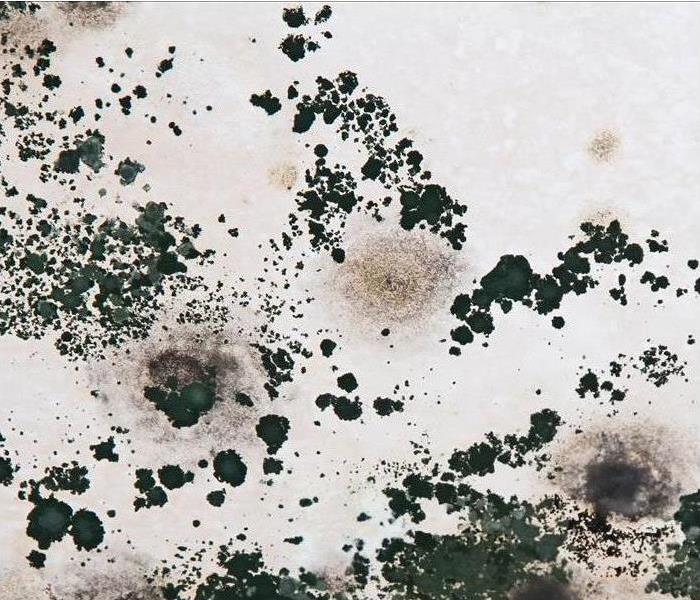 Mold growth in the corner of a wall in a back closet,
Mold growth in the corner of a wall in a back closet,
Pinterest and Google articles are just a few of the media platforms that will tell you there is a homemade way to get rid of mold in your home or place of business. DO NOT listen.
Mold spores can be deep rooted, so while you might be able to get rid of the visible mold problem with some bleach or a vinegar solution, you most likely have not gotten rid of the source.
So turn off your computers, stop your home remedy research and give SERVPRO of North Seminole County a call instead. Our licensed mold remediation specialists will be happy to set up an appointment for an FREE estimate to help you understand what you are dealing with. Then we will take care of the WHOLE issue for you, so you don't have to worry if there is any lingering effects!
Give us a call today: 407-323-2422
Preventative Measures Against Mold Growth In Your Home
11/26/2018 (Permalink)
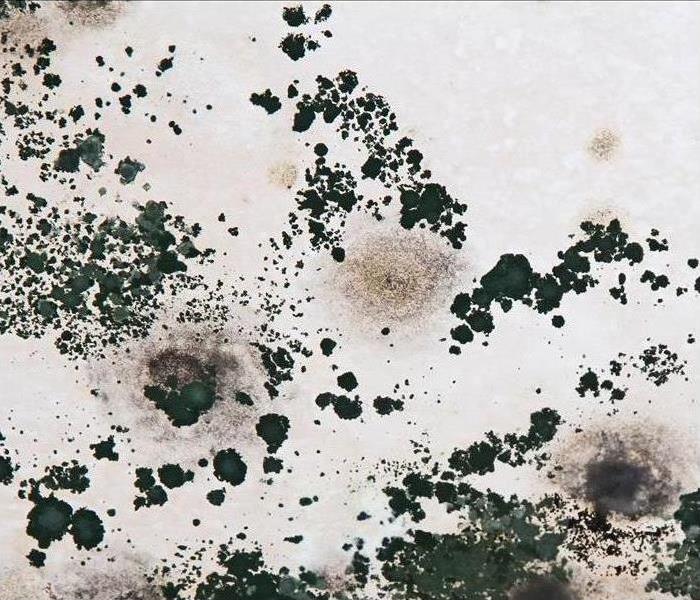 Mold growth on the ceiling of the home.
Mold growth on the ceiling of the home.
Did you know that mold spores occur naturally in our environment? Especially if you live here in Central Florida, mold spores almost always exist in some form due to our high humidity levels. However, this does not equate to a mold problem in your home, something that can be maintained through a few easy steps we will share with you below!
- Avoid long-term leaks: this one may seem obvious, but so many times we can make a temporary "quick fix" to a problem that isn't going away. Leaks are the leading cause for mold in a home so always make sure when you discover a leak that you get it taken care of right away.
- Mold loves wood: that's right, wood becomes an easy target for mold growth in the right moisture setting. That's why it is always good to use plastic or metal containers or shelving in places where high moisture levels can occur, such as a garage or a basement.
- Limit moisture in kitchens and bathrooms: Always try to make sure and vent an area that contains moisture. After you shower, turn on the vent in the bathroom for at least 20 minutes. Also, you can turn on the vents when cooking on a stove as well.
- Inspect your air conditioning unit: Finally, make sure to complete a yearly inspection of your air conditioning unit. Mold spores can get trapped and build up in certain areas causing it to expand.
Remembering these tips will not guarantee that you will never have a mold problem occur. However, it will help reduce the risk!
Testing For Mold?
10/5/2018 (Permalink)
When you should test for mold:
- Following flood damage
- Once a leak is found
- When you notice stains that you cannot explain
- When you smell mold, but cannot see it
- If someone in your home develops a medical condition that cannot be explained
THE PROCESS:
- Call for a mold inspection if you see or smell mold, or if you are experiencing health problems, most notably, difficulty breathing.
- A visual assessment can help determine where mold is located. Air samples will be taken and tested for mold spores. Once testing is complete, a report will be issued with the findings.
- If test result prove that there is in fact mold present it is important to call a mold remediation specialist, such as SERVPRO, to take care of the job. During mold remediation, professionals will use protective clothing (including masks and gloves) and the proper equipment to ensure the mold does not spread.
- Finally, air samples will be taken again once mold has been removed. A new report will be issued.
 If you have limited time at home, no need to worry as there are house mold removal services like SERVPRO of Sanford
If you have limited time at home, no need to worry as there are house mold removal services like SERVPRO of Sanford






 24/7 Emergency Service
24/7 Emergency Service






